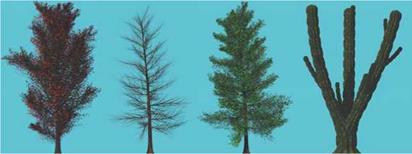While these approaches, with the exception of the particle-based procedure of Reeves and Blau, endeavor to model trees as realistically as possible, it is the affirmed goal of Weber and Penn [231] to only find approximate, though realistic-looking solutions for tree modeling. Weber and Penn’s procedure requires a set of approximately 50 parameters, all of which are described in their work. Fundamental parameters are, for instance, the overall appearance of the tree (as an enclosing geometry), the size of the lower part of the tree without branches, the number of branching levels, and the shape of the foot of the trunk.
|

For each of the maximal three branching levels, additional parameters are indicated, using an average value with an respective range of variation: vertical branching angle to the father branch, deviation angle, length relative to the father, number of branches, and phototropism (termed as a curve parameter).
Although the used model hardly shows any new aspects for the modeling of trees, the visual results are astonishing. Furthermore, methods are presented for the interaction of the models with wind and a level-of-detail representation that is further described in Sect. 10.3.



